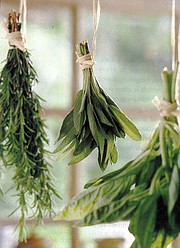It's time for final garden chores
Practicality is such a handsome word — and when garden chores make use of it, it’s better yet! We can make a big thing out of fall garden clean-up, but basically one chore can be happily ash-canned: Raking! Let practicality take over with this annual look at final “bedtime for the gardens.”
No. 1 — Leaves! Now’s the time to let them be. As the headline suggests, take it easy. Rake the paths if you wish, but if you’re lucky enough to have leaf-fall in the landscape, leave them lie! The efficacy of leaving leaves over the winter provides soil protection during hard freezes, root cover for shrubbery, and most of all, a comforting blanket and nourishment for myriad beneficial insects, hibernating toads, salamanders, garden snakes and even bumblebees!
The habit of raking it all up and bagging for the city to pick up should include only path, patio and driveway leaves — for lawn leaf-cover is also beneficial for the microbes, millipedes, crickets, worms, spiders and more that keep them healthy by suppressing weeds and fertilizing the soil.
Leaves are the perfect natural mulch, so leave them until spring thaw, then lift carefully upon removal, for you may, as I have, be delighted by the rare sight of a tiny human-handed salamander or small toad. My annual spring ladybug breakthrough comes from under the leaf-cover for my wild rose roots and stems — always a thrill.
By the way, more and more research agrees on the negative aspects of many leaf-blowers, and I am in agreement with that! My former neighbor had one so powerful its piercing scream entered my head through the walls of my house! It was terrible — they are NOT a friendly implement and Defenders of Wildlife pointed out in an article that they are an ‘environmental hazard “with a two-stroke engine that fails to undergo complete combustion, which means that they produce nearly 299 times the air pollution of a truck”! If you feel you must use one, says DFW, make it electric. New versions are now on the market, but test the sound before you make a purchase that will make your neighbors come by with a rope!
Every year at this time, I provide excerpts from a variety of sources for a final fall/winter “to do” list for Zones 3-4-5 — which encompasses our areas’ growing seasons. Here’s a repeat of a few of them.
- Conduct a “final harvest” on herbs remaining in the garden or in pots; rosemary and sage dry nicely but leafy items do better rinsed, dried and frozen in bags.
- Don’t cultivate around shallow rooted trees and shrubs such as evergreens. Roots can freeze or crack during freezes. A little mulch of leaves or straw (better than hay, since nothing eats it) can protect till snow comes to do the job.
*Leave faded flowers on those plants that form ornamental seed heads, pods or berries (rose-hips).
- Use cold weather “downtime” to sharpen mower blades, shovel edges, hoes and such to prevent leaf blade damage and lawn stress next season.
- Gather up empty pots for storage. Scrape out any residue, scrub with a sponge or old towel if necessary, and for safety’s sake, clean in a diluted bleach solution (1 part bleach to 10 parts water) and air dry.
Detach and roll up the hoses for the winter.
If you haven’t already, mulch perennials planted in large garden pots with an armful of leaves or straw; wrap the pots with burlap or other protective material. An effective solution is to create a column inside the pot with chicken wire; cut it twice as tall as the plant then dump it full of leaves. Add a cover if you wish or pinch the top together.
*Wrap the small trunks of young trees from base to first branches with hardware cloth (old Ace bandages are great!) This keeps the deer and rodents from nibbling the tender bark.
*Continue to turn the compost pile frequently, while enhancing it with potato peels, coffee grounds and eggshells for enriching gardens for next season’s planting, right up till snowfall. Then, cover the pile with a tarp or canvas, weighted down for winter’s winds and let it work and “cook” till spring.
*If you burn wood (real wood, not commercially made logs) save the ashes for use in the spring as a soil amendment of potash and/or lime where needed. A small amount may be used in the compost pile, but incorporate it well.
OK! We’ve all done what we can to ensure a safe, environmentally sound situation in the landscape. Time to put on the fuzzy slippers, make a cup of hot cocoa and sit by the window enjoying the birds at your feeders!
And that’s the final chore which is not really a chore at all! Seeing that the winter birds have suet, seeds, a water supply and nearby shelter. Their cheery presence makes even the nastiest winter bearable. Have your binoculars at the ready near a window that overlooks those hardy, happy Chickadees, Nuthatches, and assorted woodpeckers!
Next Week: Presentation!
Valle Novak writes the Country Chef and Weekend Gardener columns for the Daily Bee. She can be reached at bcdailybee@bonnercountydailybee.com or by phone at 208-265-4688 between the hours of 8 a.m. to 7 p.m.





